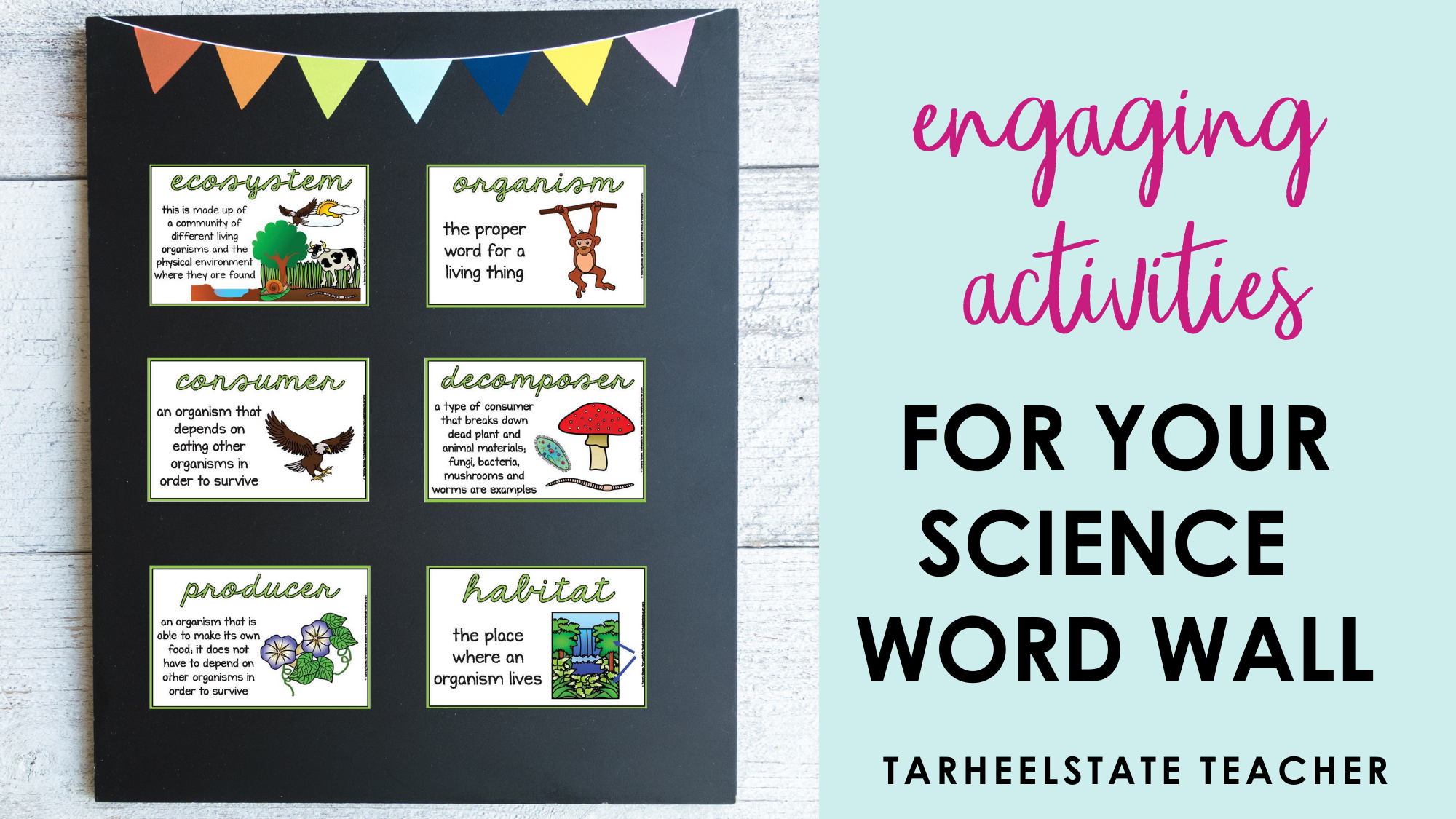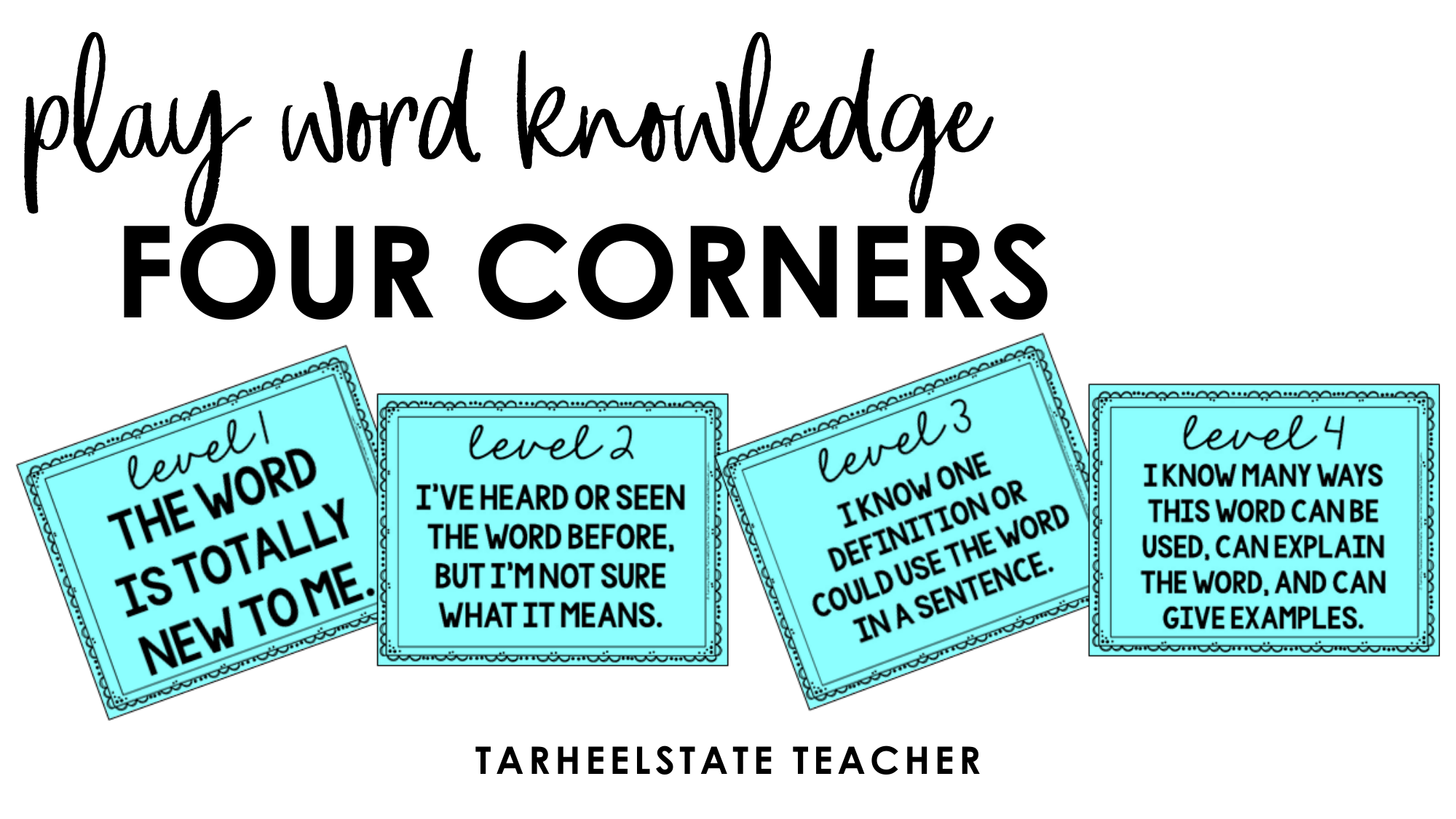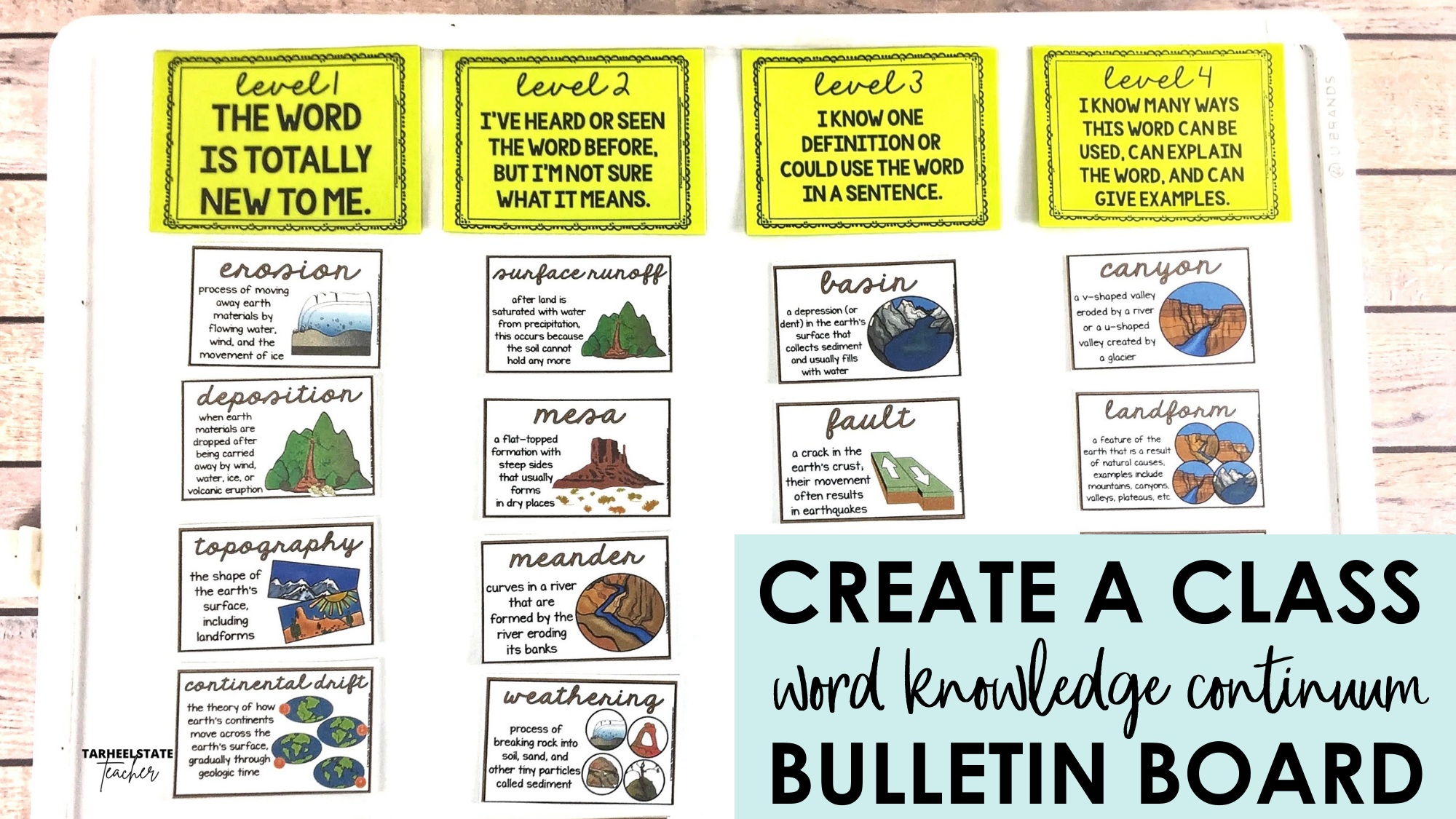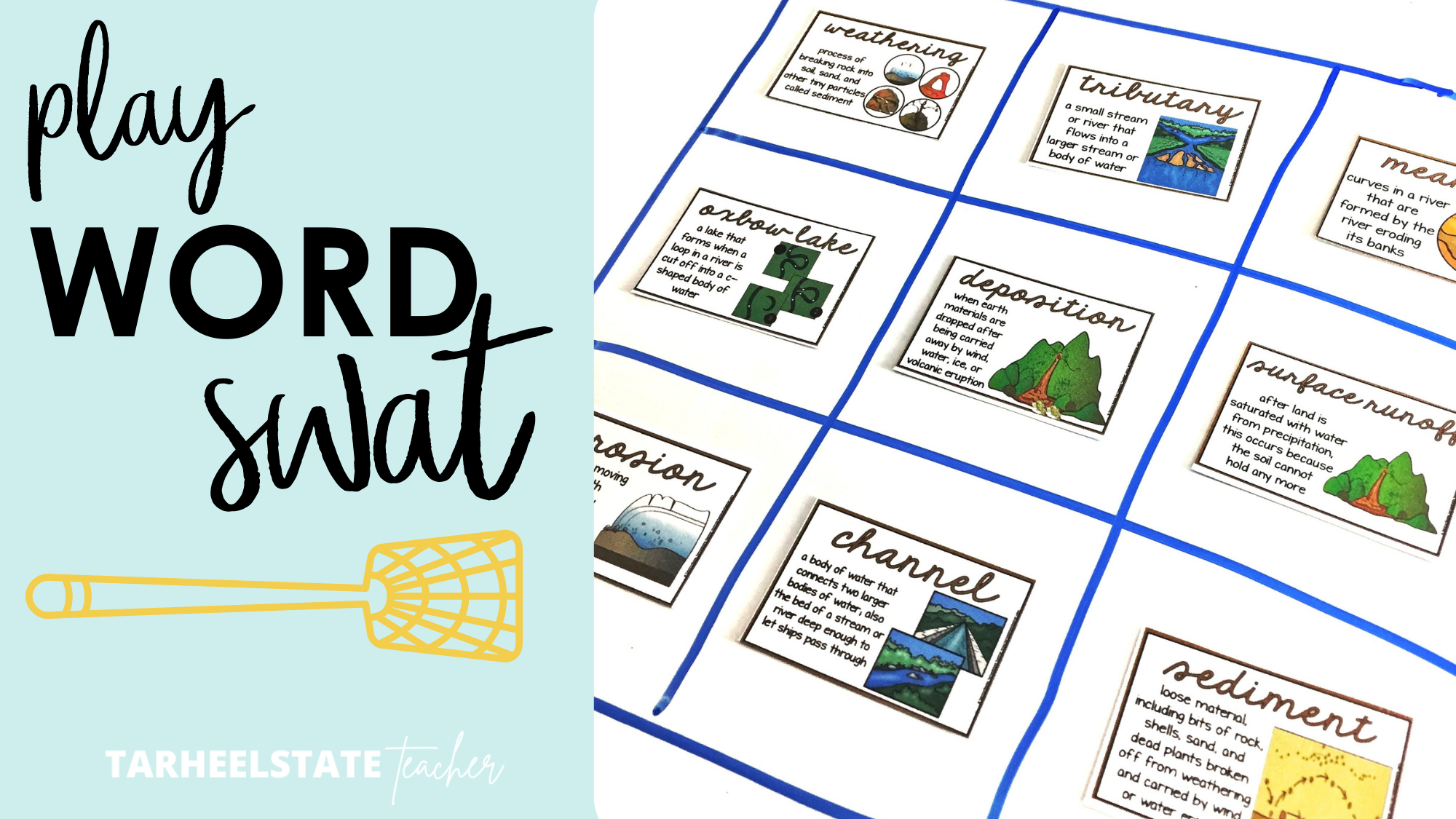Interactive Activities and Ideas for Your Science Word Wall
Looking for ideas that will take your science word wall from classroom decor to WOW OH WOW WHY DIDN'T I THINK OF THIS SOONER?!?! I have some ideas for using your word wall for more than a wall of posted vocabulary terms. I hope you find some you love and if you have some ideas I haven't thought of, I'd love for you to share in the comments!
I've included word wall activities to use at the beginning of a unit.
I believe activities like these engaging word wall ideas "prime the pump" for students to pay more attention when they hear and use the words during our science activities later on. And, after a few days of these activities and discussions, none of my students can continue to stay at a "level 1" exposure for our vocabulary terms.
I've also included word wall activities that are strategies for reviewing vocabulary terms.
Not only do I think it's important to give students multiple exposures to the words that they are expected to learn for a unit, I believe ensuring they truly master the terms and can come up with them verbally and use them in spoken and written communication about a topic, content-area vocabulary mastery is critical to their current and future success in school. I've written more about why vocabulary instruction is important and how to identify the terms that require direct-instruction in this blog post if you want to learn more.
As for now, let's get on with those engaging ideas for your content-area word walls that you can implement right away!
1) Play a game of “4 Corners” using the 4 Word Knowledge Continuum posters
I like to play a Word Knowledge 4-Corners activity as on one of the first days of starting a new unit.
Post four Word Knowledge continuum cards in each corner of your classroom.
Level 1: This word is totally new to me.
Level 2: I've heard or seen this word before, but I'm not sure what it means.
Level 3: I know one definition or could use the word in a sentence.
Level 4: I know many ways this word can be used, can explain the word, and can give examples.
Call out the vocabulary words 1 by one and allow students to move to the corner of the room that describes how comfortable and knowledgeable they are of the vocabulary term. I use a bell to quiet them and signal to let them know I am about to call out a new word. We try to play this game silently!
2) Create a Class “Word Knowledge Continuum” Bulletin Board
Prepare a bulletin board with 4 columns using the Word Knowledge Continuum Cards.
Using the vocabulary words from your science word wall, post each word under the level of comfort demonstrated by a majority of students. I typically place the word on the lower end of the spectrum when I'm just launching a unit so that everyone feels like they have the opportunity to grow.
THROUGHOUT YOUR UNIT, return to your bulletin board to discuss and move any vocabulary terms that students have become more comfortable with. (Building this reflection into your closure routines is a great idea as you can move cards after you’ve taught a lesson AND the board can show you and students what they have left to learn more about.)
Students can also keep a personal list of these words and move them to different categories as their comfort level grows.
3) CATEGORIZE/Group and LABEL
You can shrink your science word wall vocabulary cards down to smaller sizes by printing 4-8 to a page so that students can have a personal set for activities like "Categorize and Label."
In Categorize and Label, students discuss which words they think belong together and decide on a label/title to name the group of words. This can be done independently, in small groups, or whole group. (Personally, I like to have students think about the words independently, then discuss their groupings with a partner, and then we work together to create a class categorize and label display.)
If you do this activity at the beginning of a unit, I recommend allowing students to “misplace” words without telling them the right answers. As the unit goes on, refer back to the "categories and labels" groupings again and again, encouraging students to discuss any changes that need to be made.
I put magnets on the back of my word wall words so that it is easy to move them throughout the unit. This is nice if you have some whiteboard space to spare!
To make this activity even more engaging and MOVEMENT friendly, you can give each student a word and allow them to move around the room, silently grouping themselves. From this activity, I can quickly tack their groupings to a bulletin board.
4) Create Graphic Organizers/Word Relationship Maps
Have students create TACTILE vocabulary maps/graphic organizers to demonstrate the meaning and relationship between the vocabulary terms. This activity is similar to "Categorize and Label" in that students have to think about the meanings of the words and how the words for the topic fit together, but I'm sure you can guess that the
Word Relationship/Graphic Organizers
will require students to have more knowledge of the words.
This is a great activity to do towards the middle of a unit. It will allow you to see misconceptions students may have. I highly recommend having students do this activity in partners so that they have to discuss the organization of their graphic organizer. In addition, during all of these activities, I
expect and encourage students to SAY the vocabulary words. Help them correct their pronunciation and ability to sound out the words.
This will help with recognizing the word in the future and their ability to acquire the words as part of their own language resources.
Again, you can print the word wall cards in gray scale and multiple sheets on a page to shrink them down. I really like the size of 16 on a page (4x4) printed in portrait layout. This makes the cards a great size for students to construct graphic organizers that are manageable and can be glued to a poster board, chart paper, or in science notebooks.
Having students create a blank copy/"worksheet" to switch with another group is another fun way to extend the graphic organizer activity. The other student group can fill-in with the vocabulary terms and then discuss their answers with those who created the graphic organizer. Perhaps you place these in a slip cover and students can write on the sheets with an expo marker. Can you hear the collaboration and "students teaching students" that would ensue?!?! You can have students switch as much as you have time for!
5) Play WORD SWAT
Create teams of students.
Place 4-9 vocabulary words on your whiteboard. Give two students a fly swatter. (You can use your science word wall cards or just write the words on the board).
Describe one of the words using examples and/or classroom experiences. Students try to be the first to “swat” the correct vocabulary word.
Use WHITEBOARDS for a modification of this game to allow ALL students to be involved. Students can write the word being described on their whiteboard.
After a vocabulary word has been used, you can remove it and replace it with another word.
6) Play Games like HEADBANDS
Print the vocabulary word wall cards 4 to a page on card stock.
Give each student one card face down and tell them that they may NOT look at the card.
Students hold the card up to their forehead (you may also find rubber-band headbands at the dollar store that are perfect for allowing students to attach the card to their heads).
As students rotate the room, you can give them a few rules:
You may only receive 1 clue from each person you speak to
You may only ask YES/NO questions about your word
** Students should be directed NOT to say the VOCABULARY WORD or the DEFINITION in their descriptions.
7) Student-Created Fill in the Blanks/Clues :
Have students create fill in the blanks, riddles, or clues for one of the word wall words. (You can assign or allow students to choose). You can use these in a variety of ways:
At the start or end of each class, read a few clues and allow students to guess.
Create a Jeopardy type game with the clues.
Number each clue and use for a “scoot”/task card activity (great for review!). You can even type up the clues (or have students type them into a shared google doc) if you have time!
8) Laser Time!
Give students finger lasers or flashlights and turn the lights off.
Describe words from your word wall using classroom experiences, examples, and clues.
Students try to shine the light on the correct term.
You could play this activity with each student having a light or in small groups so that students have to work together and it can be more of a competition where you can keep score for the group that identifies the words first.
WHAT ACTIVITIES DO YOU USE TO MAKE YOUR CONTENT-AREA VOCABULARY WALLS MORE ENGAGING? I'm looking for more! I believe we can do a lot more than hang these words on the wall in our classrooms!
Share in the comments to help other teachers!
In need of the science vocabulary "Word Wall" work already done for you? I've created science word walls for the following topics:
Force, Motion, and Simple Machines
Weather, Weather Tools, and Clouds
Weathering, Erosion, and Plate Tectonics
Conservation of Energy and Phases of Matter
In addition, I've also put the Science Word Walls and Vocabulary Mats/Study Slips into a helpful bundle that allows you to streamline your science vocabulary activities and strategies for student mastery.
Watch the video below to see the vocabulary mats strategy in action!
You can learn more about vocabulary mats in this blog post or check out the resources below. (The bundles also includes quizzes in two formats---multiple choice and fill-in-the-blank!)
Force, Motion, and Simple Machines BUNDLE
Weather, Weather Tools, and Clouds BUNDLE
Weathering, Erosion, and Plate Tectonics BUNDLE
Conservation of Energy and Phases of Matter BUNDLE
Don't want to forget these ideas and activities for your science word wall? Pin it for later!






